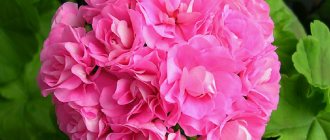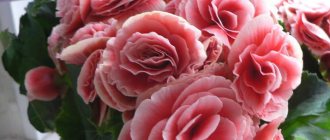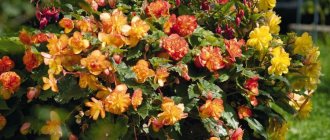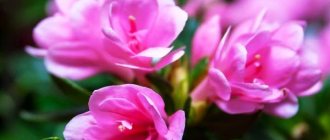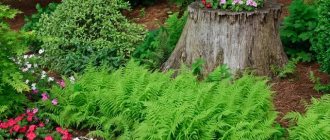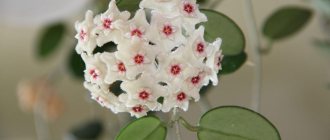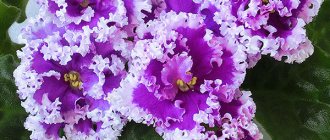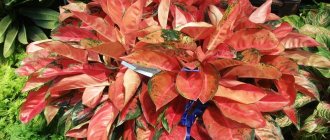Among the hybrid species of begonias, elatior occupies a special place. Bright, lush flowers of regular shape are in many ways reminiscent of chic small roses. They appear in inflorescences, several at a time. Thanks to this, the petals almost completely cover the greenery and create the effect of a beautiful flower carpet.
That is why begonia elatior is a real favorite among flower growers: it is planted both in apartments and in city flower beds.
Botanical description of the plant
This type of begonia belongs to the perennial shrubby plants. It usually grows in height up to 30-45 cm. The leaves of elatior have quite original carved shapes, in some cases they even resemble hearts with unequal halves. The stems are quite fleshy, the foliage is a rich green shade, against which the flowers contrast very harmoniously:
- red;
- white;
- cream;
- yellow;
- orange;
- pink;
- coral
Depending on the specific size of the stem, three groups of begonia elatior varieties are distinguished:
- short (about 20-25 cm);
- medium height (25-35 cm);
- tall (35-45 cm).
Varieties of begonia elatior
Here are the most interesting varieties of begonia elatior, which are often used as indoor plants:
- Baladin grows up to 30 cm, but produces flower stalks of different heights. This creates an interesting multi-tiered effect - some flowers grow on top of others. From afar, such a bush resembles a bouquet of roses. And rich bright colors always attract attention and enliven the space.
Representatives of the Baladin variety have every chance of becoming an original gift for a lovely lady - such a plant really resembles a bouquet. But this bouquet will not dry out even for several years, and it will produce flowers more than once a year.
- In distant and romantic England, another interesting variety of begonia elatior called Borias . It produces delicate flowers in pink and coral colors. And even in the photo their similarity with classic roses is striking. In this sense, elatior is truly a royal flower.
And if you put several of these pots in a row, eternal spring will come on the windowsill.
And single bushes are quite self-sufficient. And the whole point is that they produce very beautiful, rather large flowers. Needless to say, such a gift will be no less pleasant than the usual roses or tulips!
- And there is another literally bright representative of the glorious Elatior family. the Grace variety , which was developed in Southeast Asia. It grows no more than 35 cm. But it produces a lot of red flowers, which bloom several times a year. And most importantly, they do not fade within 1-2, sometimes 3 months. Needless to say, flowers are again very similar to roses, only they live much longer.
There are also varieties with beautiful orange flowers - they can create a spring atmosphere in the apartment even on long winter evenings.
How to care for begonia elatior: 10 flowering secrets
Caring for any plant is based on one important rule: for the flower you need to create conditions that are as close as possible to its natural habitat. In the case of begonia elatior, it is important to remember that the birthplace of this flower is the distant tropics.
This means that the plant is accustomed to eternal summer, fairly abundant watering and fertile soils. But everything is good in moderation. Therefore, in order to achieve lush and stable flowering, you should pay attention to the following tips:
- It is very important to ensure optimal watering . It should be quite abundant - as soon as the upper half of the soil has dried, a new portion of settled water should be added. However, overfilling is even worse - the water in the pan should not stagnate too much.
- Moist air is another rule for caring for begonia elatior at home. Spraying the leaves and especially the flowers is unacceptable, but placing a bowl of water next to the plant or placing a damp towel is a mandatory measure in the summer.
- Lighting should be diffused , but at the same time bright. This is very easy to achieve - you can simply place the pot behind the tulle, and in the summer, cover the lower part of the window with a sheet of white paper. Elatior, unlike many other types of begonias, does not need additional lighting even in cloudy weather or in the autumn-winter period.
- The plant is located away from drafts and heating radiators - cold and dry, hot air are equally harmful to begonias.
- The optimal temperature is slightly lower than normal room temperature: +18°C...+20°C . The air should not cool below +16°C - the plant will shed its buds and may even get sick.
- During the flowering period (from the beginning of the formation of buds until the flowers wither), complex mineral fertilizers are used . They are taken in small quantities (compared to the instructions in the instructions, 1.5-2 times less), since begonia does not like soil salinity. It is better not to feed with organic matter - due to nitrogenous substances, the plant loses its vigor, and the flowers lose their visual appeal.
- For planting, you can take any pot, but the soil is selected from peat, leaf and greenhouse humus (in equal quantities). You can add a little river sand and perlite. The soil must be loose and airy.
- Almost every year, a young plant is transplanted into a new pot , which is 4-5 cm in diameter larger than the previous pot. And it is not advisable to disturb a flower that is already 4 years old (or more).
- Periodically, faded leaves should be removed , as well as flower stalks after the petals have withered. This is done with a sharp knife, and the cut areas are covered with wood ash.
- And one more rule for caring for begonia elatior at home is regular inspection for the presence of diseases and the appearance of pests, as shown in the photo (using the example of gray rot).
How to sterilize soil correctly
The likelihood of introducing the disease to plants through the soil is low. It is only 20%. Most cases are infected or weak seeds. The likelihood of infection through a purchased substrate is even less. But amateur flower growers and gardeners use different methods of soil sterilization. But not all of them actually work and are not as useful as many people think.
There is an opinion among gardeners and flower growers that potassium permanganate can disinfect the soil from pathogenic bacteria. But that's not true. Professional agronomists claim that when potassium permanganate gets into the soil, it quickly disintegrates and the number of microorganisms dangerous to plants does not decrease.
Potassium permanganate can be used to soak seeds. A solution of potassium permanganate can help open the pores of seeds, which has a positive effect on germination. Brilliant also has zero effect if used as a disinfectant.
Steaming the soil is also of dubious benefit. This is due to the fact that during sterilization using a double boiler, not only pathogenic bacteria and fungi die, but also microbes beneficial to plants. But harmful microorganisms take root better in a disinfected substrate.
For example, Staphylococcus aureus will feel great in such soil, because all competitive microflora was previously killed by steaming. To protect against diseases, it is better to use special means that stimulate phytoimmunity. And also water the soil with antibacterial agents for plants to eliminate the possibility of bacterial diseases.
Attention! To get rid of parasites, larvae, and insect eggs, you need to calcine the soil using a microwave or oven for 15-20 minutes at a temperature of 200 degrees. This procedure will not destroy beneficial microflora, but will kill insects and other pests.
Reproduction at home in different ways
This flower is propagated by seeds, cuttings, and also by simply dividing the mother bush into several daughter bushes. The simplest methods of propagating begonia elatior at home are described in detail and clearly in the video.
But growing begonia elatior from seeds is somewhat more difficult, and the rules for caring for seedlings are not simple. However, this method of reproduction is also available.
It is better to purchase seed material in a specialized store. They sell seeds in 2 forms:
- Regular (unprocessed).
- Granulated (in the form of dragees) - they are easier to work with.
Regardless of the type of material, the planting technology is the same (planted at the very beginning of spring):
- The seeds are pre-treated with a 1% solution of potassium permanganate for 30-45 minutes.
- They are then washed and planted in a pre-moistened peat tablet.
- Each tablet is placed on a tray, which is covered with polyethylene or glass.
- Then water is constantly added to the tray so that the surface of the tablet is always moderately moist. The room temperature is at least 20-22oC.
- Normally, the first shoots appear after 2-3 weeks. After the formation of the third leaf, a pick is made.
- They dive again 8 weeks after emergence. At the same time, the sprouts are planted in pots.
Other important points of care
Begonia Elatior's shoots can stretch out unsightly, especially with short daylight hours, so the plant is pinched several times to form a compact, neat bush.
Feed 3-4 times per season: with potassium fertilizer at weekly intervals almost immediately after planting (to gain green mass), then with complex fertilizer for flowering plants.
When cold weather sets in, plants from open ground can be transplanted into a pot and stored in the room.
Diseases and pests of begonia elatior
Disturbances in the development of begonia elatior are associated mainly with improper maintenance conditions and infectious pathogens of flower diseases.
The most common ones include:
| external sign | cause | solution |
| the leaves dry out at the edges and begin to curl | dry and hot air | move to a cooler place, periodically humidify the air |
| leaves fall off or turn yellow and droop | too cold | move to a warmer place |
| the foliage has drooped | polluted air or lack of moisture | take the pot to another room, water it thoroughly (if the soil is dry) |
| leaves grow small, flowers do not form or bloom rarely | lack of fertilizer | fertilize the soil using organic or mineral fertilizers |
| leaves fade, cobwebs are found | spider mite activity | use an insecticide or onion infusion (more details below) |
| powdery coating with greenish and brown tints | activity of gray mold fungus | spray with fungicide (benomyl) according to instructions and remove the pot to a dry, cooler place |
| white spots of powdery consistency | activity of powdery mildew fungus | |
| the roots turn black and rot | black root rot fungus activity | stop watering, spray with fungicide, remove to a drier place |
| rot on the surface of leaves and flowers | waterlogging | reduce watering, do not allow moisture to get on the begonia itself when spraying |
| leaves are deformed, yellow spots appear on the surface | activity of cucumber mosaic virus | destroy the flower, disinfect the pot, replace the soil |
| the leaves have lost color, sagging is visible on the roots | nematode activity |
As for begonia pests, the most dangerous are:
- The spider mite is a round-shaped insect, bright red in color, less than 1 mm long. They look like numerous bright dots on the surface of leaves and stems. Leaves cobwebs throughout the plant.
- Aphids have different colors (green, gray, brown), the body shape is round, 2-3 mm long. They look like numerous gray dots.
They need to be dealt with immediately after detection. For this purpose, special insecticides are used, which can be purchased at a specialty store:
- thiophos;
- karbofos;
- actellik;
- neoron;
- fitoverm;
- fufanon.
They act exactly according to the instructions. You can also use a home remedy based on regular onions (with brown peel):
- The onion is chopped very finely or passed through a meat grinder.
- Take a full teaspoon (half a tablespoon) and leave for 1 week in a liter of water.
- Strain and spray the foliage and stems until the insects are completely destroyed.
PREVENTION ADVICE
The foliage and especially the stems of the plant hidden under the bush must be carefully inspected for the presence of pests and other damage. The sooner you start fighting them, the higher the chances of success.
Reviews from gardeners about begonia elatior
In general, flower growers are very pleased with representatives of the Begonia elatior species. As a rule, such flowers are purchased in disposable pots, then transplanted into durable containers and sprayed with fungicide to avoid the development of fungi and bacteria.
Begonia owners note that the plant pleases with its beautiful, bright flowers almost all year round.
Of course, reviewers also talk about certain shortcomings. Basically, gardeners describe how the plant begins to quickly turn yellow and wilt due to lack of watering or spraying the leaves with a spray bottle. It is often pointed out that Elatior is quite difficult to care for.
However, it is worth keeping in mind that beauty almost always requires sacrifice. And of course, in the case of such an interesting indoor plant, the word “victim” is inappropriate.
Moderate watering, sufficient heating and lighting are the basic rules for success. You should frequently inspect your pet for pests or signs of disease. Otherwise, caring for begonia elatior at home is as simple as caring for less demanding plants.
Useful video
In this video you can learn more about plant care:
If you find an error, please select a piece of text and press Ctrl+Enter.
A compact bush strewn with bright flowers of various shades is a real replacement for quickly fading bouquets.
This incredibly beautiful plant is the Elatior begonia variety.
It can bloom twice a year, creating a cozy atmosphere in the house and putting its owners in a positive mood.
In this article we will look at how this plant reproduces and how difficult it is to care for it.
